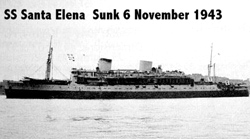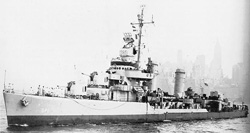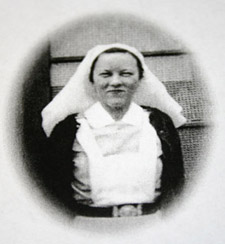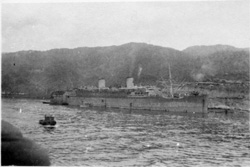

Harvey Cenotaph Index Page
Margaret Agnes Briggs (Service Record & Bigraphical Data)
Newspaper Articles and Obituaries
In memory of
Lieutenant (Nursing Sister)
MARGARET AGNES BRIGGS, RCAMC
Jan 1910 - February 22, 1945
Convoy KME-25A (Liverpool to Naples) November, 1943
--------------------------------------------------------------------------------
During the first week of Nov 1943, Convoy KME-25A was assembled in Great Britain to transport war supplies and thousands of troop reinforcements for the army of General Mark Clark in Naples, Italy. With the clearance of debris and booby traps Naples was becoming a major base for the allied ground forces fighting in Italy.
SS Santa Elena was carrying 1800 Canadian soldiers and 121 nursing sisters when it was torpedoed off Philippeville, North Africa on 6 Nov. 1943.
Medium sized pop up image
433 X 240, 72 dpi, 77 kConvoy KME-25A consisted of 8 British and 15 American transports escorted by 7 American, 3 British and 2Greek destroyers, as well as the anti-aircraft vessel HMS Colombo. Of most interest to Canadians was the transport S.S. Santa Elena, a luxury liner with the Grace Line before the war, which was carrying 1800 Canadians, including 121 Canadian Nursing Sisters of No. 14 Canadian General Hospital.
Prior to departure the nurses, including LT. (NS) Margaret A. Briggs were given 48 hours to pack and were not told their destination even after the convoy was at sea. The voyage from Liverpool to the Mediterranean was routine and uneventful. Due to U-boat activity the convoy followed the standard zig-zag pattern. There was little to fear from air attack though as there was allied air cover. The convoy steamed along the Algerian coast but was too large to pass through the Tunisian War Channel in the standard formation of columns of three ships each. Instead the convoy was strung out in less maneuverable and more vulnerable, seven and nine ship columns. The Allied air screen also disappeared at this time.
The escort destroyer USS Tillman (DD-641) picked up 36 of the female hospital staff after they had abandoned the SS Santa Elena.
Medium sized pop up image
688 X 367, 72 dpi, 131 kBy Nov 6 the ships had left Algiers behind and were approaching Philippeville at 12 knots. At exactly 1800 not far from Cape Bougaroun a Luftwaffe mixed force of nine bombers and 16 torpedo planes came in low dropping torpedoes and deploying radio controlled glider bombs.
The destroyer USS Beatty (DD-640) was hit by a torpedo on the starboard side at the after engine room. The ship came to halt and sagged in the water with a broken keel. The damaged hull could not stand the strain of the flooding and the ship broke in two and sank with the loss of twelve sailors. Two transports were also torpedoed; the S.S.Aldegonde and the S.S.Santa Elena.
Aboard the S.S. Santa Elena there was a deafening explosion that shook the ship. The engines stopped and power was lost. The ship began to drift and started to take on water. The ship took a second hit when a bomb crashed into the deck near the stern.
The order came to abandon ship and the nurses put on life jackets and got into the lifeboats. Some soldiers panicked and jumped into the water. Many of them subsequently clung to the sides of the lifeboats.
LT. (N/S) Margaret A. Briggs, RCAMC. Source: Paul Briggs, via Brenda MacMinn, 2006.
Medium sized pop-up image
691 X 1036, 72 dpi, 905 kThe nurses took to the oars in some life boats and helped row around in circles until they were rescued two or three hours later. Two boatloads, including thirty-six of the hospital's female staff, were taken aboard the American destroyer USS Tillman (DD-641).
The nursing sisters in the other boats were faced with a scary fifty-foot climb up the towering side of the S.S. Monterey, another former luxury liner turned troopship that was standing by to pick up survivors. The nurses' "hardening" training in England had not included practice with scramble nets that hung down the liner's side, swaying outward with each roll of the ship. But with dogged perserverance all made the difficult ascent to the deck of the Monterey, many using their elbows rather than their hands to haul themselves up. Lt. Margaret Briggs fell into the sea from forty feet up, but was rescued by a Chinese cook who dove in from a lifeboat. There was no loss of life in the abandonment.
The crew and Armed Guard returned to the Santa Elena on Nov 7. However, the ship suffered further damage when accidentally rammed by another damaged ship, the Dutch transport Marnix Van St. Aldegonde (then under tow). The Monterey attempted to tow the Santa Elena but the ship could not stand the strain and sank off Phillipville Harbour, North Africa. The nurses and soldiers lost all of their possessions and equipment. Four of the 133-man merchant crew unfortunately perished in the final abandonment of the Santa Elena.
SS Monterey was carry 7000 US soldiers as part of convoy KME-25A but took on an additional 1800 Canadian soldiers and most of the nursing sisters of No 14 Canadian General Hospital after the SS Santa Elena was struck by a torpedo.
Medium sized pop up image
552 X 368, 72 dpi, 125 kRough weather prevented the Monterey from docking at Phillipville, and she was ordered to proceed to Naples. The same heavy seas also prevented attempts to transfer the nurses that were on the Tillman to the Monterey.
They were put ashore at Philippeville, and spent a week as guests of No. 15 General Hospital at El Arrouch before taking ship to Naples.
In the action report report following the incident the configuration of Convoy KME-25A was severely criticized. Convoy speed was unnecessarily slow. It was concluded tat troop ship convoys should steam at the maximum speed of the slowest ship and rendezvous should be arranged accordingly. Having fast ships carrying 4000 to 7000 troops steam at speeds of a slow12 knots was deemed foolhardy. A number of large ships in the convoy were capable of eighteen knots or better and the Monterey carrying 7000 troops was capable of 20 knots. It was thus concluded that convoys should be split into two groups upon entering the Mediterranean into a fast and slow group.
References
http://www.geocities.com/Pentagon/Base/1250/dd615smith.html
http://www.mayoff.com/perth-history.html
http://www.armed-guard.com/sheehan.html
--------------------------------------------------------------------------------



